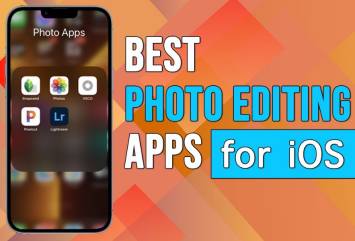Transform Your Vision: Best Photo Editing App for iPhone Creative Excellence Guide
Mobile photography has evolved beyond simple snapshots to become a legitimate art form, with smartphones now capturing images that rival professional cameras in quality and creative potential. Best photo editing app for iPhone solutions have kept pace with this revolution, offering powerful tools that transform ordinary photos into stunning visual masterpieces through intuitive interfaces designed specifically for touchscreen workflows.

The democratization of professional-grade photo editing on mobile devices has empowered millions of creators to express their artistic vision without expensive desktop software or complex technical knowledge. Modern iPhone photo editors combine sophisticated algorithms, artificial intelligence, and precision control that enable everything from subtle exposure adjustments to dramatic creative transformations that define contemporary visual culture.
This comprehensive exploration examines the leading photo editing applications for iPhone across all skill levels and budgets, from completely free options to professional-grade subscriptions, helping photographers and content creators identify the perfect tools for their unique creative workflows and artistic aspirations.
What is the Best iPhone Photo Editor App?
Adobe Lightroom Mobile stands as the undisputed champion for serious iPhone photographers, offering unparalleled editing power combined with seamless workflow integration across devices. The app provides comprehensive adjustment tools including selective masking, raw file support, AI-powered object removal, and cloud synchronization that enables editing projects to flow effortlessly between iPhone, iPad, and desktop computers.
Photomator represents the best value alternative to Lightroom’s subscription model, delivering nearly identical functionality for $39.99 annually or $119 as a one-time purchase compared to Lightroom’s $143.88 yearly cost. The app supports both classic RAW and Apple ProRAW formats while offering machine-learning denoise, selective masks, and excellent iOS ecosystem integration.
For users prioritizing simplicity over power, Snapseed provides completely free professional-grade editing with Google’s intuitive interface and U Point selective adjustment technology. While lacking some advanced features and receiving infrequent updates, Snapseed delivers exceptional value through zero-cost access to tools typically locked behind premium paywalls.
Apple Photos serves casual editors who need quick, effective adjustments without learning complex applications. The built-in editor includes all essential tools like exposure correction, color adjustment, and perspective control, plus iOS 18.1’s Clean Up feature for AI-powered object removal on newer iPhone models.
Which is the No. 1 Photo Editing App?
Adobe Lightroom Mobile dominates professional mobile editing with the most comprehensive toolset, highest quality output, and largest user community providing tutorials and preset libraries. PC Magazine’s 2025 testing confirms Lightroom as “best for professionals and serious amateurs” due to its deep post-shot editing capabilities and raw format support.
Market statistics reveal Lightroom’s dominance, though exact download numbers fluctuate based on promotional periods and competitor launches. The app consistently ranks among the top five photography applications globally across both iOS and Android platforms, demonstrating sustained popularity despite subscription requirements.
User satisfaction surveys from photography communities including Reddit consistently place Lightroom at the top for feature completeness and professional workflow integration. Amateur Photographer’s 2025 comprehensive testing rated Lightroom as “best for Raw image editing” after evaluating over 15 competing applications.
The New York Times Wirecutter named Adobe Lightroom the best photo editing app after extensive testing of 10 mobile editors, praising its “huge range of adjustments, high-quality output, and excellent library-style file organization” that serves photographers from beginners to professionals.
Does Apple Have a Photo Editor Like Photoshop?
Apple offers Pixelmator as the closest equivalent to Photoshop on iPhone, providing layer-based editing, selection tools, filters, and advanced retouching capabilities in a native iOS application. While not developed by Apple originally, the company acquired Pixelmator in 2024, suggesting potential deeper integration into the Apple ecosystem.
Pixelmator costs just $9.99 as a one-time purchase, dramatically cheaper than Adobe’s subscription model while delivering sophisticated editing tools including PSD file import/export compatibility. The acquisition by Apple may eventually change the pricing structure, though current users benefit from subscription-free ownership.
Apple Photos includes basic editing that handles most casual user needs but lacks Photoshop’s advanced features like layers, complex selections, content-aware fill (beyond simple object removal), and extensive filter libraries. The built-in editor focuses on photographic adjustments rather than creative manipulation.
For users requiring true Photoshop-level capability, Adobe offers Photoshop Express (limited free features) and full Photoshop for iPad that work on iPhone with reduced functionality. These provide legitimate Photoshop experiences on mobile devices, though the subscription costs and complexity may exceed typical user requirements.
Which Photo Editor is 100% Free for iPhone?
Snapseed by Google provides completely free professional editing without advertisements, in-app purchases, or feature limitations. The app includes comprehensive tools like selective adjustments, healing brush, perspective correction, HDR effects, and 29 different editing tools that rival premium applications.
Apple Photos comes pre-installed on every iPhone with full editing functionality at zero additional cost. The native app handles essential adjustments efficiently while integrating seamlessly with iCloud photo library and offering AI-powered features like Clean Up on compatible devices.
Photoshop Express offers limited free functionality including basic adjustments, filters, and one-tap corrections without subscription requirements. Adobe restricts advanced features like healing tools, premium looks, and raw editing to paying subscribers, creating a freemium model that satisfies casual users.
VSCO provides substantial free editing tools alongside its social platform, including 10 free preset filters and basic adjustment capabilities. The company monetizes through VSCO Membership ($59.99/year) that unlocks additional presets and advanced tools, but the free tier satisfies many content creators.
Best Photo Editor Android: Cross-Platform Considerations
While focusing primarily on iPhone, understanding Android alternatives helps users with multiple devices or considering platform switches. Adobe Lightroom, Snapseed, VSCO, and Photoshop Express all offer identical functionality across iOS and Android, ensuring seamless workflow continuity.
Android-exclusive editing apps like PicsArt and Photo Editor Pro (by InShot Inc) have garnered massive followings with hundreds of millions of downloads. These apps prioritize creative effects, collage making, and social features that appeal to Instagram-focused content creators.
Cross-platform compatibility matters increasingly as users maintain multiple devices. Apps supporting both ecosystems enable consistent editing workflows regardless of hardware, avoiding the frustration of learning different applications for different devices.
Photo App iPhone: Native Capabilities Explored
Apple Photos has evolved significantly from simple filters to a sophisticated editing platform incorporating AI-powered enhancements, Live Photo effects, and advanced adjustment tools. iOS 18.1 introduced Clean Up for removing unwanted objects and Visual Look Up for identifying locations in photos.
The portrait mode editing within Apple Photos enables depth control, studio lighting effects, and blur adjustment specific to iPhone’s computational photography. These specialized tools optimize edits for images captured with iPhone’s portrait features.
ProRAW support in Apple Photos enables professional-grade raw editing within the native app, combining raw format flexibility with Apple’s computational photography enhancements. This hybrid approach delivers exceptional quality while maintaining the Photos app’s simplicity.
iOS Gallery: Photo Management Integration
Photo organization within editing apps varies significantly, with Lightroom offering the most sophisticated library management through album creation, star ratings, color labels, and powerful search functionality. This professional cataloging system suits photographers managing thousands of images.
Apple Photos excels at automatic organization through AI-powered facial recognition, location tagging, and Memories feature that creates automatic slideshows. The seamless integration with iPhone’s camera and iCloud makes it effortless for casual users.
Dedicated gallery apps like Google Photos provide alternative organization with generous free cloud storage (with compression) and excellent search capabilities. Many users maintain multiple gallery systems, using different apps for storage, organization, and editing purposes.
Apple Photo Editor: Advanced Features Breakdown
Machine learning powers modern Apple Photos through automatic subject detection, sky replacement suggestions, and intelligent auto-enhance that analyzes image content before applying optimal adjustments. These AI capabilities democratize professional results for non-technical users.
The adjustment interface uses intuitive sliders for exposure, brilliance, highlights, shadows, contrast, saturation, warmth, and other parameters. Advanced users access granular controls while beginners rely on one-tap auto-enhance functionality.
Portrait lighting effects simulate studio lighting setups including Natural Light, Studio Light, Contour Light, Stage Light, and Stage Light Mono. These computational photography features create professional portrait results impossible with traditional photography alone.
Snapseed Editing: Google’s Free Powerhouse
Snapseed’s selective adjustment system revolutionized mobile editing through U Point technology enabling localized edits with simple taps. Users select areas and adjust brightness, contrast, saturation independently without complex masking processes.
The healing brush removes unwanted objects through intelligent content-aware fill that analyzes surrounding pixels. While not as sophisticated as Photoshop’s version, Snapseed’s healing tool handles most removal tasks effectively.
HDR Scape creates dramatic high dynamic range effects from single images, popular among landscape and architectural photographers seeking bold, impactful results. The tool offers natural and dramatic intensity levels for varied aesthetic preferences.
Photo Editor APK: Understanding Installation Methods
iPhone users cannot install APK files, as this Android-specific package format doesn’t work on iOS. iPhone apps come exclusively through the App Store in IPA format, ensuring security through Apple’s review process.
The walled garden approach means iPhone users avoid concerns about malicious APKs or sideloading security risks common on Android. All photo editing apps install through the official App Store with verified developer credentials.
TestFlight enables beta testing of pre-release photo editing apps on iPhone, providing early access to new features while maintaining Apple’s security framework. Developers distribute beta builds through Apple’s official testing platform.
Lightroom iOS: Professional Mobile Workflow
Adobe Lightroom Mobile provides desktop-class editing through comprehensive adjustment panels including tone curve, HSL sliders, split toning, lens corrections, and transform tools. The mobile interface adapts these professional tools for touchscreen efficiency.
Cloud synchronization represents Lightroom’s killer feature, maintaining edit synchronization across iPhone, iPad, and desktop seamlessly. Changes made on any device instantly appear everywhere, enabling flexible workflows that adapt to available equipment.
Preset ecosystem includes thousands of community-created looks available through Adobe’s marketplace and third-party sellers. One-tap presets provide professional styling while remaining fully customizable for personal refinement.
Raw editing capabilities support Adobe’s DNG format plus native raw files from professional cameras imported through card readers. This professional-grade raw processing delivers maximum quality and editing flexibility.
Download Photo Editor: Finding Legitimate Apps
The App Store remains the only legitimate source for downloading iPhone photo editing apps, ensuring security through Apple’s review process. Avoid websites promising direct IPA downloads, as these violate Apple’s terms and may contain malware.
Verifying app authenticity involves checking developer credentials, reading user reviews carefully, and avoiding suspiciously cheap clones of premium applications. Legitimate developers maintain active support and regular updates.
Free trials for subscription apps enable testing before committing to purchases. Adobe, VSCO, and other premium editors offer trial periods ranging from 7 to 30 days for evaluating whether features justify subscription costs.
Future of iPhone Photo Editing
Artificial intelligence increasingly powers photo editing through generative fill, automatic sky replacement, subject isolation, and intelligent enhancement that understands image content. These AI capabilities will become more sophisticated, potentially eliminating manual adjustments.
Computational photography continues blurring lines between capture and editing as iPhone cameras perform real-time processing. Future distinctions between “camera” and “photo editor” may become meaningless as editing integrates deeper into the capture process.
Cross-device workflows will improve through better cloud integration and standardized file formats. Professional photographers increasingly demand seamless editing across iPhone, iPad, and desktop without format conversion or compatibility concerns.
Choosing Your Perfect iPhone Photo Editor
Best photo editing app for iPhone selection depends entirely on individual needs, skill levels, and budget constraints. Professional photographers benefit from Lightroom’s comprehensive tools and workflow integration, while casual users find Apple Photos perfectly adequate for quick enhancements.
Understanding the strengths and limitations of different editing applications empowers informed decisions that align with creative goals and technical requirements. Whether embracing free options like Snapseed, investing in Photomator’s one-time purchase, or subscribing to Lightroom’s professional ecosystem, excellent choices exist across all price points.
The evolution of mobile photo editing continues accelerating through AI innovation, computational photography advances, and cloud-based workflows that make iPhones legitimate tools for professional content creation. Success requires matching photo editing app capabilities with personal creative vision while continuously developing the technical skills that transform powerful software into compelling visual art.

Editor-in-chief in charge of reviewing an article before it is published on applerepo.com
